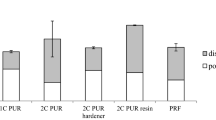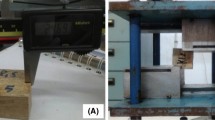Abstract
Eight adhesive formulations were developed using two types of resin by urea–formaldehyde (UF) and melamine-urea formaldehyde (MUF) resins and four levels of sodium montmorillonite (Na+MMT) nanoclay by 0, 2.5, 5, and 7.5% as a secondary filler for interior beech plywood adhesives. Mechanical strength from experimental panels bounded with these formulations demonstrated that resin type and different levels of nanoclay have not any significant differences on modulus of rupture face grain parallel to span, modulus of elasticity face grain parallel and perpendicular to span, and glueline shear strength. But, for modulus of rupture face grain perpendicular to span, the highest value was calculated for MUF along with 5% nanoclay formulation. Furthermore, the results of physical properties showed that Water absorption and thickness swelling after 2 and 24-hour immersion in cold water for MUF resin was less than that of UF resin. In addition, the least amounts for thickness swelling after 24-hour immersion in cold water were attained for UF resin, along with MUF resin both treated by 5% nanoclay as a secondary filler.







Similar content being viewed by others
References
Angelatos AS, Burgar MI, Dunlop N, Separovic F (2004) J Appl Polym Sci 91:3504
ASTM D 1037-99 (2005) Standard test methods for evaluating properties of wood-based fiber and particle panel materials. Vol 04.10, West Conshohocken, PA, USA
ASTM D 3043-00 (2000) Standard Test Methods for Structural Panels in Flexure. Vol. 04. 10, West Conshohocken, PA, USA
Boding J, Jayne BA (1982) Mechanics of wood and wood composites. Van Nostrand Reinhold Company, New York, p 712
Cao MS, Guan CB, Xu JQ (2001) Introduction of Nano-material. Harbin Institute of Technology Press, Harbin, pp 5–23
Doosthoseini K (2002) Wood composite materials, manufacturing, applications. Vol. 1 (Fundamentals). University of Tehran Press, Tehran, Iran
Doosthoseini K, Yasini AA (1995) Using wood flour as urea–formaldehyde resin filler in the plywood manufacturing. Iranian J Nat Resour 47:45–57
Du GB (1995) Application of mineral filler of urea formaldehyde resin as plywood adhesive. China Adhes 4(1):39–42
Halvarsson S, Edlund H, Norgren M (2008) Properties of medium-density fibreboard (MDF) based on wheat straw and melamine modified urea formaldehyde (UMF) resin. Ind Crop Prod 28:37–46
Hse CY, Fu F, Pan H (2008) Melamine-modified urea formaldehyde resin for bonding particleboards. Forest Prod J 58(4):56–61
ISO 12466-2 (1999) Plywood bonding quality—Part 2: requirements, 1st ed
ISO 12466-1 (1999) Plywood-bonding quality—Part 1: test methods, 1st ed
ISO 16983 (2003) Wood-based panels-determination of swelling in thickness after immersion in water, 1st ed
ISO 9427 (2003) Wood-based panels-determination of density, 2nd ed
Kamoun C, Pizzi A (1998) Performance effectiveness of addition to UF of melamine salts vs. melamine alone in MUF adhesives for plywood. Holz Roh Werkstoff 56(1):86
Knudsen RM, Stout RMT, Rogerson DE (1978) Plywood glue extender from particleboard sander dust. FPJ technical Note. Forest Products Research Society, Madison, WI
Kollmann FP, Kuenzi EW, Stamm AJ (1975) Principles of wood science and technology—Vol 2 (wood based materials). Springer-Verlag, Berlin, Heidelberg, New York
Lei H, Du G, Pizzi A, Celzard A (2008) Influence of nanoclay on urea-formaldehyde resins for wood adhesives and its model. J Appl Polym Sci 109:2442–2451
Liang L (1996) Application of hardener and filler of urea formaldehyde resin adhesive. Mod Chem Ind (1):49–50
No BY, Kim MG (2004) J Appl Polym Sci 93:2559
OH YS, Sellers JRT (1999) Korean filler raw materials for plywood adhesives. Forest Prod J 49(3):61–64
Philbrook A, Blake CJ, Dunlop N, Easton CJ, Keniry MA, Simpson JS (2005) Polymer 46:2153
Pizzi A (1994) Advanced wood adhesive technology. Marcel Dekker, New York
Pizzi A, Lipschitz L, Valenzuela (1994) J Holzforschung 48:254
Qi B, Zhang QX, Bannister M, Mai YW (2006) Investigation of the mechanical properties of DGEBA-based epoxy resin with nanoclay additives. Composite Structures 75(1–4):514–519
Qiaojia L, Guidi Y, Jinghong L, Jiuping R (2006) Property of nano-SiO2/urea formaldehyde resin. Front For China 2:230–237
Siimer K, Christjanson P, Kaljuvee T, Pehk T, Lasn I, Saks I (2008) TG-DTA study of melamine urea–formaldehyde resins. J Therm Anal Calorim 92(1):19–27
Ston JB, Robitschek P (1978) Factors affecting the performance of plywood glue extenders. Forest Prod J 28(6):32–35
Strickler MD, Sawyer EW Jr (1974) Attapulgite Clay-a filler for exterior plywood adhesives. Forest Prod J 24(11):17–22
Tohmura SI, Inoue A, Sahari SH (2001) Influence of the melamine content in melamine-urea-formaldehyde resins on formaldehyde emission and cured resin structure. J Wood Sci 47:451–457
Tomita B, Hse C (1995) Analysis of cocondensation of melamine and urea through formaldehyde with carbon 13 neuclear magnetic resonance spectroscopy. Mokuzai Gakkaishi 41:349
Yang GD, Lin QJ, Liu JH (2004) The effects of nano-SiO2 on the properties of the urea formaldehyde resin. J Fujian For Coll 24(2):114–117
Acknowledgments
The authors are grateful to the Vice Chancellor for Research, University of Tehran (Project No. 7204004/1/2) for supporting this research.
Author information
Authors and Affiliations
Corresponding author
Rights and permissions
About this article
Cite this article
Doosthoseini, K., Zarea-Hosseinabadi, H. Using Na+MMT nanoclay as a secondary filler in plywood manufacturing. J Indian Acad Wood Sci 7, 58–64 (2010). https://doi.org/10.1007/s13196-011-0012-9
Received:
Accepted:
Published:
Issue Date:
DOI: https://doi.org/10.1007/s13196-011-0012-9




